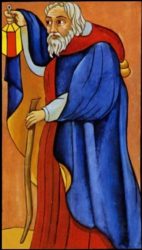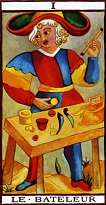In Letter XXI, the Fool, Valentin Tomberg describes the characteristics of the Bodhisattva to come:
He will not simply explain the profound meaning of revelation, but he will bring human beings themselves to attain to the illuminating experience of revelation, of a kind that it will not be he who will win authority, but rather He who is “the true light that enlightens every man coming into the world” (John 1:9)—Jesus Christ, the Word made flesh, who is the way, the truth and the life.
Not very long ago, a Jain was explaining that his people were expecting the coming of the next avatar. I asked him how he would recognize the avatar when he appeared. He was flummoxed by the question and told me he would get back to me after consulting with his guru in India. Needless to say, he never got back to me.
So how would we, in the West in our time, recognize the Bodhisattva when he comes? Does he arrive with a certificate of authenticity, a diploma, a letter of introduction? Perhaps he will appear on TV or even perform an occasional miracle? Rudolf Steiner made the same point this way:
It is certainly true that in our time there is a rooted disinclination to recognise genius in human beings. But on the other hand, mental laziness is very prevalent, with the result that people are only too ready to acknowledge some individual as a great soul, merely on authority.
The disinclination is the lack of the ability to recognize a higher teaching, or even the denial that such a teaching is possible. Although Tomberg warned about this, the personal and subjective elements are much more attractive than pure intellectuality. Mental laziness is tied to the “bandwagon effect”, so that a “great soul” is confounded with a “greatly popular soul”. Tomberg then gives us a clue:
The mission of the Buddha-Avatar to come will therefore not be the foundation of a new religion, but rather that of bringing human beings to firsthand experience of the source itself of all revelation ever received from above by mankind, as also of all essential truth ever conceived of by mankind. It will not be novelty to which he will aspire, but rather the conscious certainty of eternal truth.
We see that we will not recognize the Bodhisattva not through anything external, but rather by re-experiencing firsthand what the Bodhisattva experienced. Before considering Tomberg’s description of that experience, a short detour is necessary.
The Right Track
The teaching of moral development is not the same as the impulse for such development. ~ Rudolf Steiner
For the kingdom of God is not in word, but in power. 1 Corinthians 4:20
Tomberg claimed that Rudolf Steiner was “on the right track” in his understanding of the coming Bodhisattva. Now there are several areas of incompatibility between Steiner and Tomberg, so we will focus solely on what may have been on the right track. In 1911, Steiner delivered a lecture in Milan titled Buddha and Christ: The Sphere of the Bodhisattvas. There he expanded on a legend from the Middle Ages about the Bodhisattva:
Consciousness of this truth was demonstrated in a beautiful legend written down by John of Damascus in the eighth century and well known throughout Europe in the Middle Ages. It is the legend of Barlaam and Joshaphat, which relates how he who had become the successor of Buddha (Joshaphat is a phonetic variation of ‘Bodhisattva’) received teaching from Barlaam about the Christ Impulse. The legend, which was subsequently forgotten, tells us that the Bodhisattva who succeeded Gautama Buddha was instructed by Barlaam and his soul was fired by the Christian Impulse. This was the second impulse which, in addition to that of Buddha, continues to work in the evolution of humanity. It is the Christ Impulse and is connected with the future ascent of humanity to Morality. Although Buddha’s teaching is in a particular sense moral teaching, the Christ Impulse is not teaching but actual power which works as such and to an increasing degree imbues mankind with moral strength.
That passage makes the important distinction between a moral teaching (as an intellectual exercise) and the power to act on that teaching.
The Two Streams
In our period of evolution, two streams of spiritual life are at work; one of them is the stream of Wisdom, or the Buddha-stream, containing the most sublime teaching of wisdom, goodness of heart and peace on Earth. To enable this teaching of Buddha to permeate the hearts of all men, the Christ Impulse is indispensable. The second stream is the Christ-stream itself which will lead humanity from intellectuality, by way of aesthetic feeling and insight, to morality. ~ Rudolf Steiner
Tomberg sees the two streams in a slightly different way. He recognizes the Buddha-stream like Steiner, but he attributes the second stream to the coming of the Kalki Avatar as taught in Hinduism. The first stream represents spiritual humanism, i.e., the realization of all human possibilities on the natural plane. The second stream represents spiritual religion, or the realization of supernatural possibilities.
The two activities that will activate these possibilities are respectively meditation and prayer.
Spirituality and Intellectuality
Even if the Bodhisattva arrives on the historical plane, we will recognize him by his inner teaching. Specifically, we need to re-enact the spiritual alchemy in our own consciousness; only then we will recognize the Bodhisattva. There are three stages:
- the experience of the separation and opposition of the spiritual and intellectual elements within one’s soul
- advancement to parallelism, i.e. a kind of “peaceful coexistence” of these two elements
- cooperation between spirituality and intellectuality which, proving to be fruitful, eventually becomes the complete fusion of these two elements in a third element —the “philosopher’s stone” of the spiritual alchemy of Hermetism.
The third stage is reached when the intellectual life if no longer dominated by formal logic, but passes through organic logic and finally to moral logic. The urge to dispute, argue, analyze, and judge is the fruit of formal logic. This stage is dominated by the reign of quantity.
Organic logic deals with qualities rather than quantities. It sees the whole, while formal logic focuses on the parts. The former synthesizes, the latter analyzies.
Finally, moral logic deals with values. This manner of thinking is invisible to those on the first stage of formal logic. Using Tomberg’s example, the world, in terms of formal logic, operates by logical and natural necessity. However, according to moral logic, the world is created in an act of love. “Hate and indifference are not creative,” only love is. Vatican I made the dogmatic declaration that Christian faith could not be compelled by natural or formal logic. Otherwise, androids would all become Christians.
So Tomberg can assert that the essential articles of faith are established by moral logic. Hence, God is Love or else there would have been no creation. A big bang has no desire to create a universe. The soul is immortal, or else morality would make no sense. Man is free, otherwise he could not even be moral. Moral logic is the language of the spiritual world, so we should be sure to make it part of our prayer life.
Prayer and Meditation
Moral logic is, as Tomberg asserts, the logic of the head and heart united. It unites meditation and prayer. He describes prayer in these words:
Prayer—which asks, thanks, worships and blesses —is the radiation, the breath and the warmth of the awakened heart: expressed in formulae of the articulated word, in the wordless inner sighing of the soul and, lastly, in the silence, both outward and inward, of the breathing of the soul immersed in the element of divine respiration and breathing in unison with it.
Prayer has three aspects:
- Magical aspect: formulaic and liturgical prayer
- Gnostic aspect: an inexpressible inner sighing
- Mystical aspect: the silence of union with the Divine
Meditation, which is the gradual deepening of thought, also has three stages:
- Pure and simple concentration on a subject
- Understanding the subject within the totality of relationships that is has with reality
- Intuitive penetration into the very essence of the subject
Tomberg repeats Rene Guenon’s writings on this topic, and it is worth repeating here:
Metaphysics is not human knowledge. Thus, it is not in so far as he is man that man can attain it; it is the grasping in effective consciousness of supra-individual states. The very principle of metaphysical realisation is identification through knowledge—according to Aristotle’s axiom: a being is all that he knows.
The most important means is concentration. Realisation consists initially in the unlimited development of all possibilities contained virtually in the individual, then in finally going beyond the world of forms to a degree of universality which is that of pure being.
The final aim of metaphysical realisation is the absolutely unconditioned state, free from all limitation. The liberated being is then truly in possession of the fullness of his possibilities. This is union with the supreme Principle.
Christian Meditation
Guenon’s teaching is correct as far as it goes. Nevertheless, Christian meditation seeks to go beyond even that. God is revealed both through Scriptures and Creation. Christian meditation therefore seeks a more complete consciousness and appreciation of Christ’s work of redemption. Hence, the subject of mediation will be the seven stages of the Passion, for example. There are further subjects for mediation which will be covered at a different time. But the goal is to return to the state of primordial purity before the Fall.
By the alchemical marriage of prayer and meditation, we may recognize the Bodhisattva.


